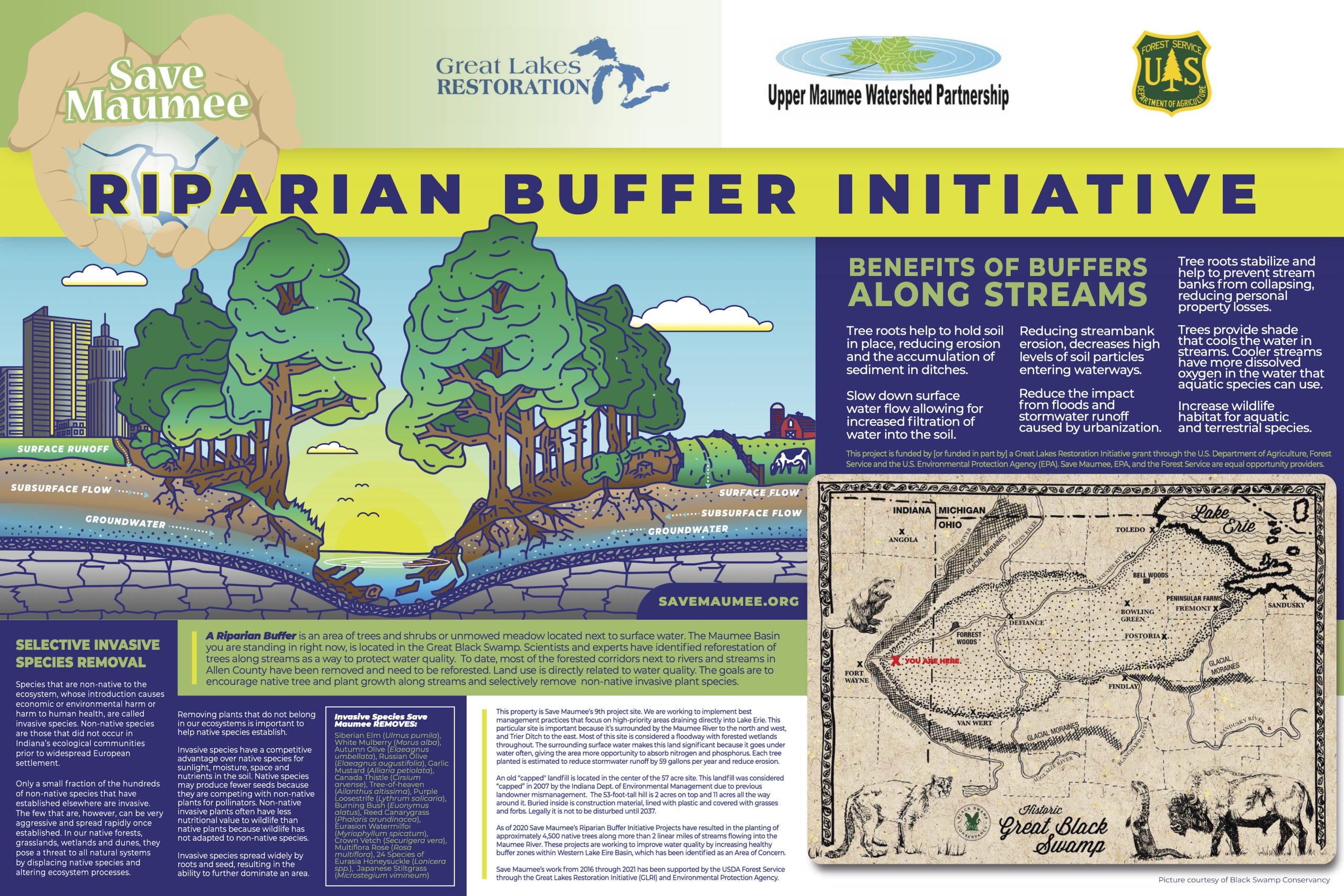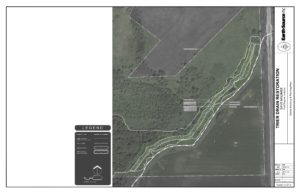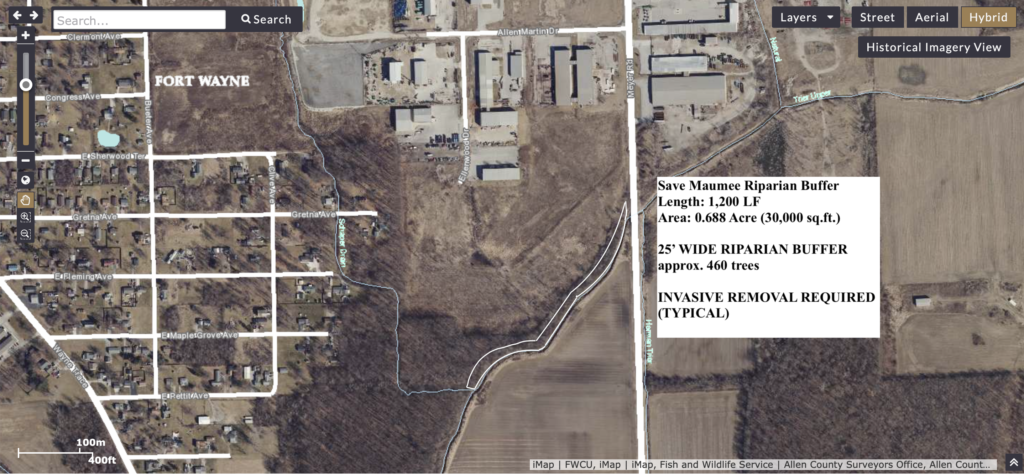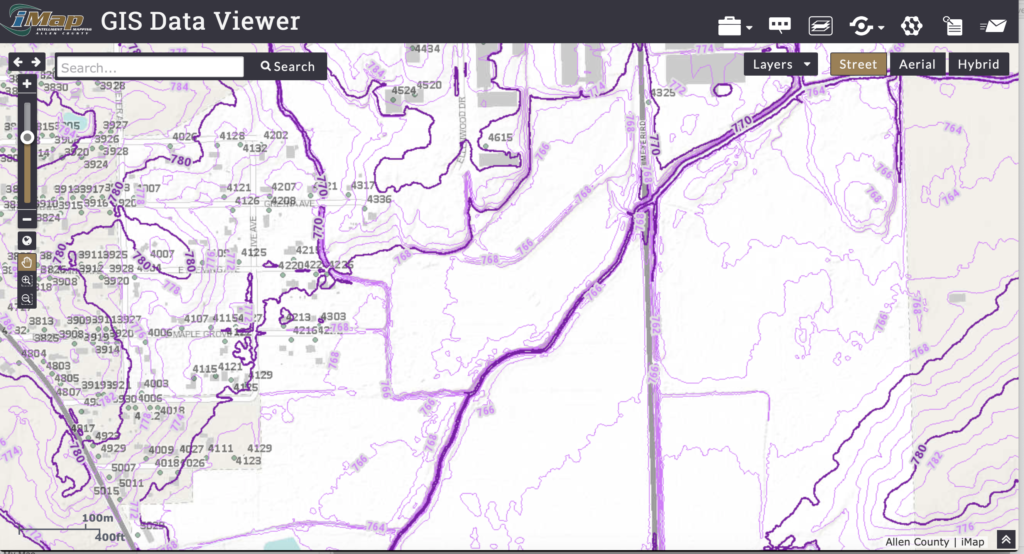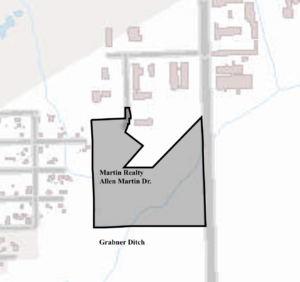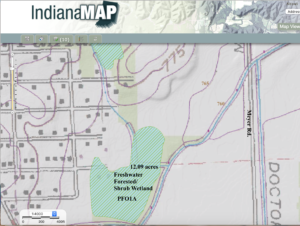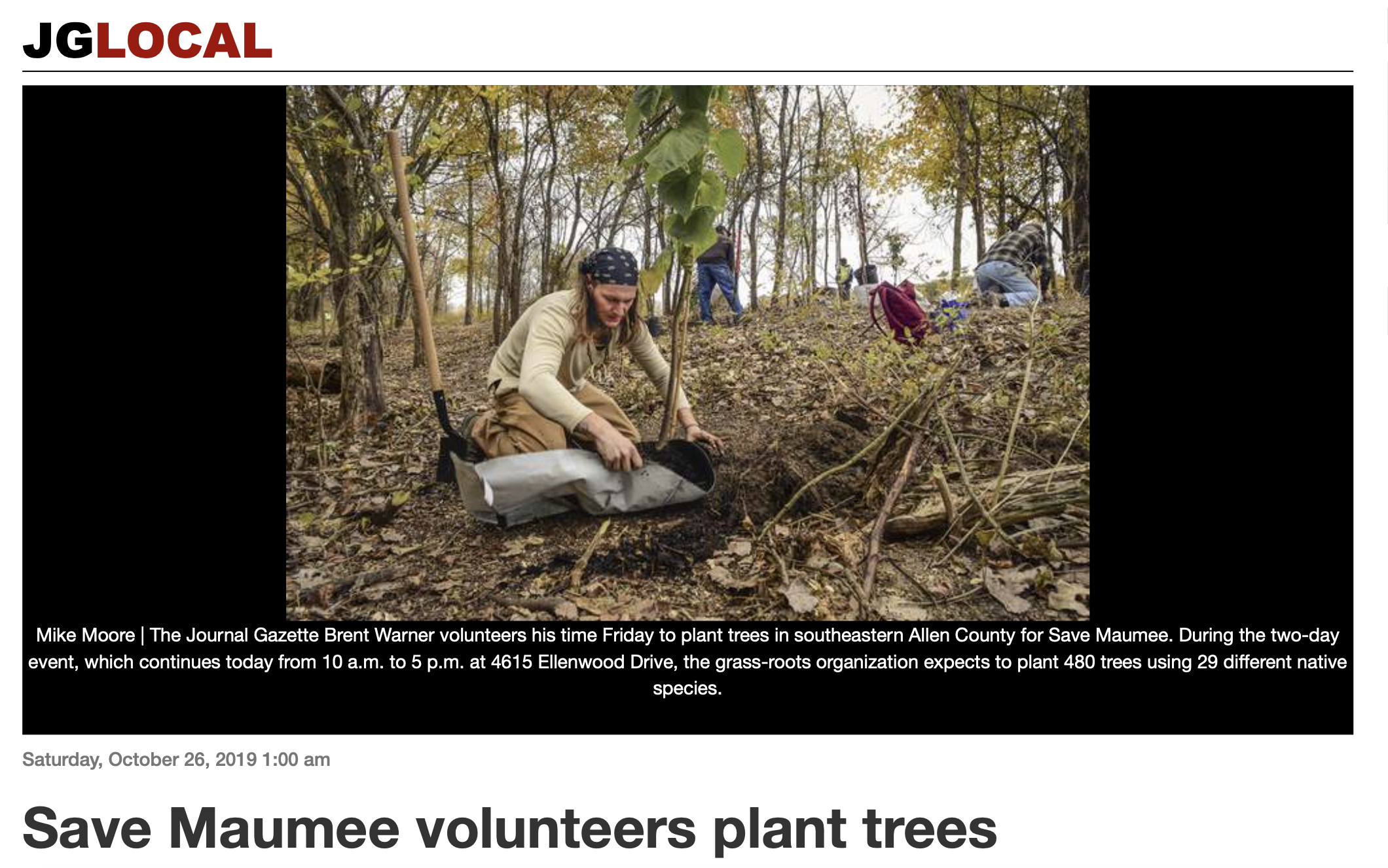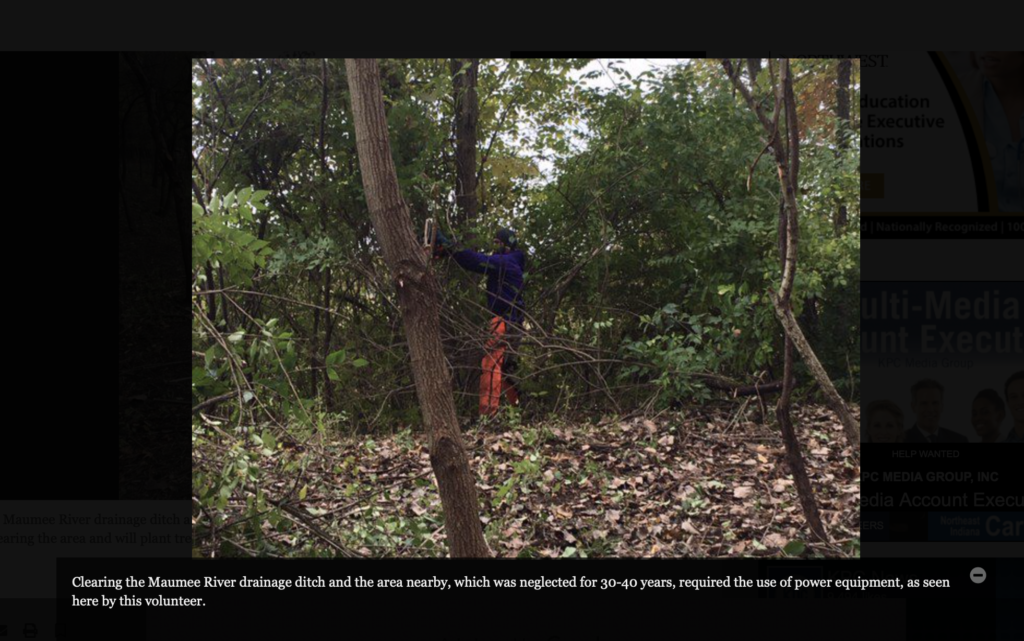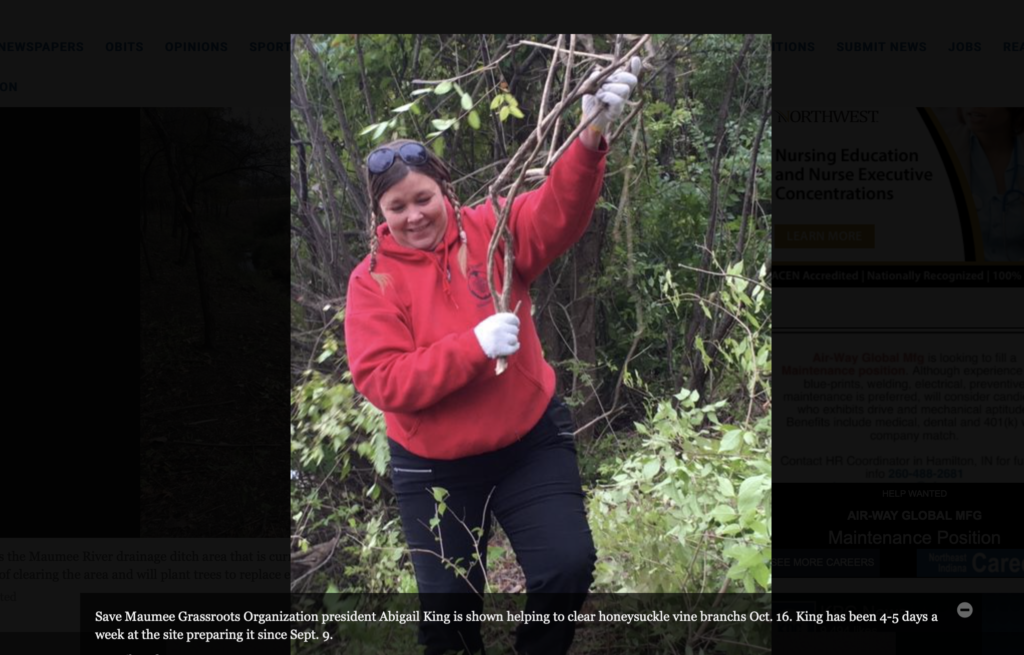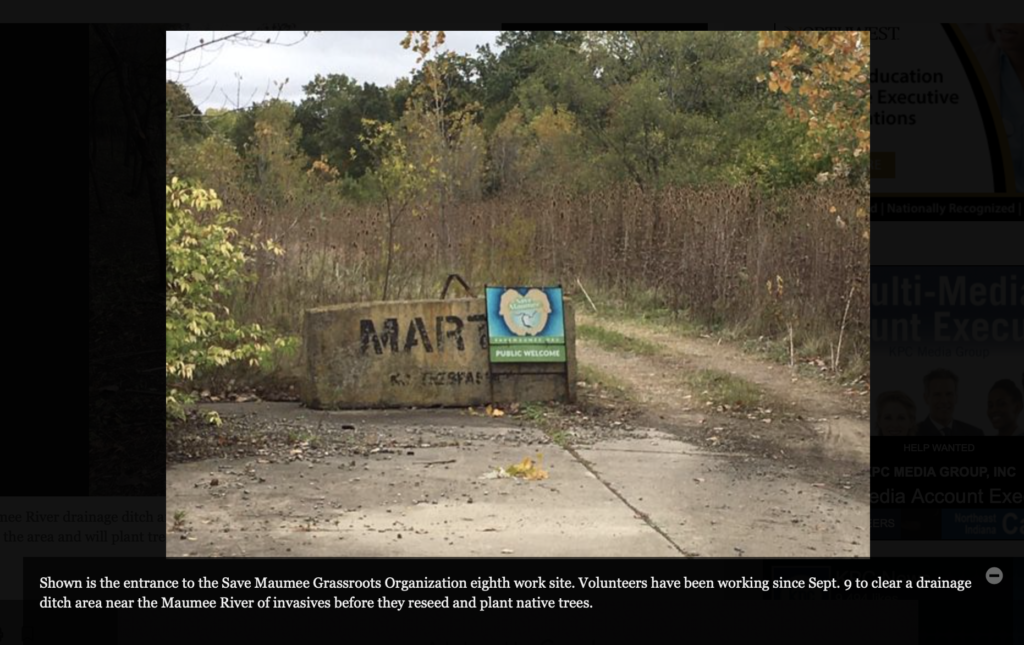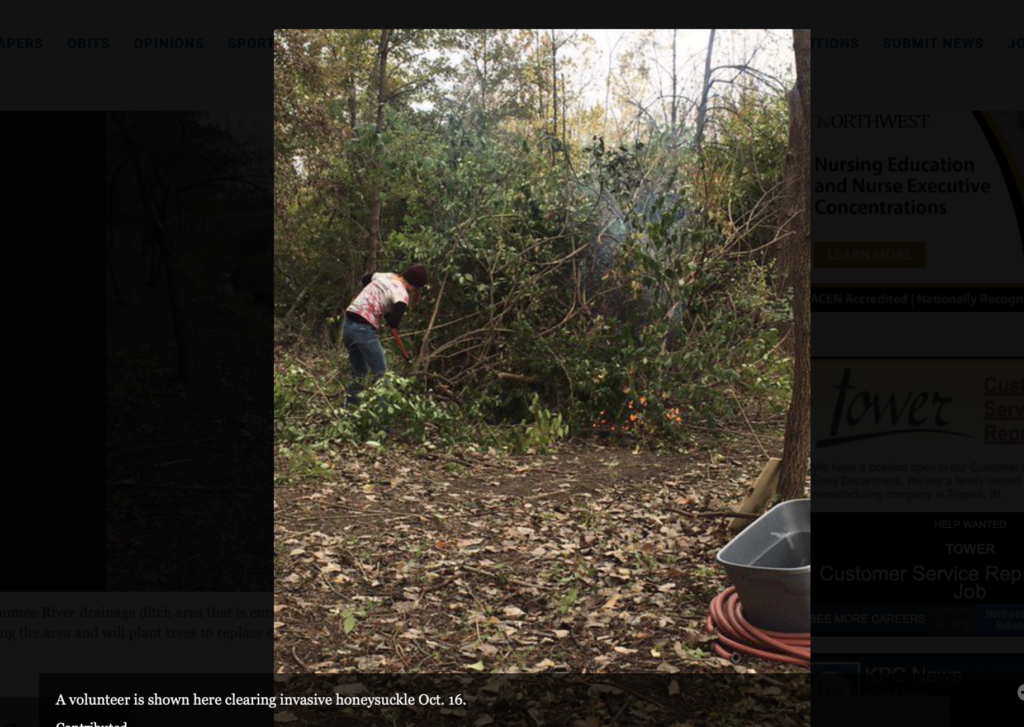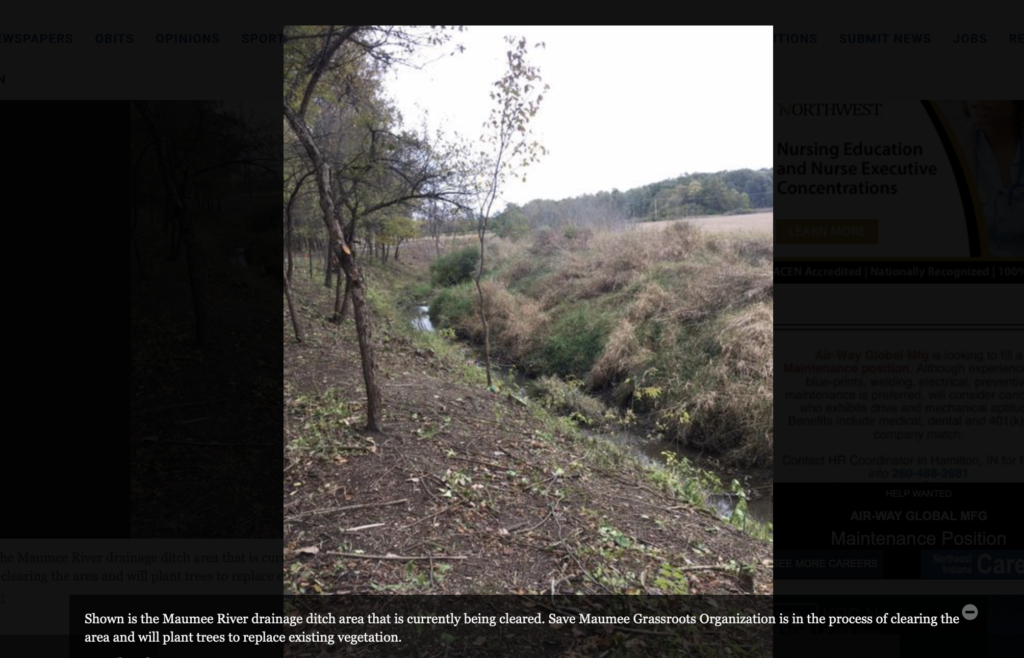“Ellenwood Site”
Completed Oct. 25 & 26, 2019
2-Day Public Event
Tree Planting on Trier Ditch
Planted 482 Trees ~ 28 Different Native Species
…along the legal drain, south of Ellenwood Drive and West of Meyer Rd
CLICK HERE TO SEE ALL PICS
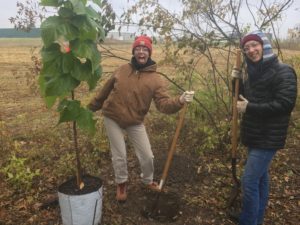
This was Save Maumee’s 8th project (8 of 9)where 83 people planted 482 trees along 1,200 linear feet (by approximately 40 feet wide) of the Upper Trier Ditch), on the north/west side of the ditch.
- Previous Save Maumee Riparian Buffer Initiative:
PROJECTS 1 through 6
PROJECT 7 through 9 - Native tree species we plant: CLICK HERE
- Why we remove invasive species before we plant trees: CLICK HERE
Save Maumee Riparian Buffer Initiative began to prepare this site in September 2019 by selectively removing the invasive species which do not belong there, to make space for the new trees!
Save Maumee Upper Trier Drain Plans
Tree Species Selection: Yellow Buckeye, Bitternut Hickory, Shagbark Hickory, Northern Catalpa, Hackberry, Butternut, River Birch, Sweetgum, Black Gum, Quaking Aspen, Swamp White Oak, Bur Oak, Swamp Chestnut Oak, Chinquapin Oak, Pin Oak, Pussy Willow, Black Willow, Sassafras, Bald Cypress, American Basswood
Shrub Species: Selection Serviceberry, Spicebush, Ninebark, Elderberry, Swamp Rose, Aarowwood Viburnum, Blackhawk Viburnum, Nannyberry
Save Maumee Riparian Buffer Initiative ordered & installed all 482 trees at Save Maumee’s 2-Day Planting on October 25 & 26, with 28 different species (requirement of 460 trees). Twenty-two additional trees were purchased and planted due to perfect seasonal weather. The entire project area completed for this site along the Upper Trier Ditch is 1,200 linear feet of riparian buffer by a width of about 45 feet throughout. This area now yielding >1.25 acres of added native forest along one fo the most critical areas of the Upper Maumee River’s sub-watersheds.
The location is adjacent to zoned “heavy industrial” complexes, but the soils were healthy enough for large trees to be installed, and will reduce stormwater runoff by approximately 28,438 gallons per year. Our calculations of stormwater retention comes from the Environmenal Protection Agency (EPA) using current standard of 59 gallons/tree/year for the amount of average runoff reduced per tree. https://www.epa.gov/soakuptherain/soak-rain-trees-help-reduce-runoff. Most trees were between 3-7 gallon sized. The 482 trees were planted (on average) 1 tree every 7-10 feet or so. Larger diameter of trees were selected, available and within budget.
The Ellenwood site does not have an address to designate this location. This site lies south of Ellenwood Drive and west of Meyer Road and designation is Zoned Industrial / Floodplain (private property owned by Gerald Martin (Martin Realty). It is in-between the City of Fort Wayne / City of New Haven municipality boundaries in Indiana, on the Upper Trier Ditch. The Ellenwood site lies just upstream and southwest of the Meyer Rd. site. The excessive, undisturbed growth added to project cost. Ellenwood’s ditch bank is south of the historical zoned “industrial” area and retained at least 30 years of undisturbed growth of bush honeysuckle, callery pear and other invasive species that were removed previous to tree planting. Our project selectively retained many of the Cottonwood, Box Elder, Dogwood, Willows (Salix exigua exigua or S. exigua interior), Pin Oak (Quercus palustris), Quaking Aspen (Populus tremuloides), Eastern Red Cedar (Juniperus Virginiana) and Smooth Sumac (Rhus typhina) along this “abandoned” ditch.
It took 7 weeks for volunteers and contracted workers to clear the invasive shrubs along the entire ditch, 1,200 linear feet by approx. 45-50 feet wide, and selectively retain native species. All invasives were stump treated with glyphosate brand AquaNeat the same day. Each day, after the clearing another 70 feet (or so), native seed blend was spread in bare areas and along the slope of the ditch-bank.
Save Maumee’s dedicated volunteers logged 1,069.25 hours in September & October 2019 for this project alone. Volunteers are the #1 reason our projects are successful. 317.5 hours were logged by 89 different volunteers for the 2-Day Public Tree Planting on October 25 & 26. Invasive removal was difficult and the very dedicated volunteers logged 729.25 hours over the course of 7 weeks leading up to the tree planting and over 22.5 hours to clean-up after the public event. During that time, we also checked the trees from the adjacent site (Meyer Rd. April 2019 tree planting) and the trees were all growing well and in good condition on October 31, 2019.
It is important to note that the removal of invasive species (primarily bush honeysuckle) will continue to add costs to all of our projects in the future. For example, it was only 1,000 linear feet from parking lot, to the ditch bank itself. It took one full working day to create a walking path from where we park, to the perennial stream. There were NO ticks and it was decided that lack of deer paths would correlate to no ticks due to the lack of mammals (i.e. livestock) that would transfer tick species!
The difference between “before” (the first day we began to clear honeysuckle) and “after” (the tree planting) was exclaimed dramatically by volunteers, “It is a new forest!.” Volunteers were able to plant these large trees quickly because trees and mulch were moved into place over two days, before the 2-Day public event.
All bare areas from invasive removal were seeded with a native seed blend 1) at each days end, after the invasive species were cleared, 2) after the mulch came and trees were placed.
July through November 2019 partners include Carriage House Mental Health Services, Allen County Corrections, Whitley County Corrections, Manchester University, Big Brothers/Big Sisters, Northeast Indiana Chapter Sierra Club, and Upper Maumee Watershed Partnership and a few private companies have provided advertising and volunteers.
This event was then shared and promoted by;
Livable Futures Expo
Black Swamp Permaculture Convergence
United We Stand Concert
Little River Wetlands “Protect Our Species” Earth Day Event
Food Not Lawns Garden Mob Event, “Resistance is Fertile”
The Great American Clean-Up
Sol Fest
Plowshares Workers Project
Public invited to help plant native trees Oct. 25-26
By Emeline Rodenas For IN | FW Newspapers Oct 23, 2019
FORT WAYNE— The overgrown ditch by the Maumee River may once have been an eyesore filled with overgrown vegetation, but it’s now getting a face-lift, thanks to the Save Maumee Grassroots Organization.
According to Save Maumee Grassroots Organization president Abigail King, the area had been neglected for 30-40 years until volunteers stepped in to clean it up. Overall, the area is approximately 1,200 feet long and 50 feet wide; as a result, it’s divided into five sections, so crews can access other sections once one has been cleared.
The organization’s purpose statement is to “preserve, protect and improve the eco systems of the Upper Maumee River and watershed by increasing public awareness through advocacy, collaboration, education and hands-on projects, according to their website.
This particular site is private property owned by Martin Realty, and lies in a floodplain and drainage easement.
“Save Maumee works to make the land better, it does not matter if it is public or private. If you want to know how to improve water quality, look at land-use,” King said.
According to King, the Allen County Surveyors Office is responsible for all the regulated drains and ditches in the county, totaling approximately 2,500 miles.
“Many ditches are cleared of trees, they aren’t replanted, which leads to tall grasses overtaking the bank,” she said, pointing out canary grass growing abundantly on one side of the ditch at the project site Oct. 16.
Since Sept. 9, King’s group of volunteers has already spent weeks removing invasive species, including Asian honeysuckle, a vine that grows uncontrollably and smothers native plant life, to make way for a better habitat next to this major drainage ditch that flows into the Maumee River.
During that time, they’ve battled very rainy conditions followed by strong winds, which makes controlled burns difficult.
“I’ve been out here 4-5 days a week since Sept. 9,” King said. .
Progress is slow, but it doesn’t stop people from having a good time. When out clearing, volunteers bring lawn chairs, coffee mugs and snacks to share. The clearing helps Mother Nature and allows teams to form bonds with each other. They sometimes listen to music too.
King credits her volunteers for their hard work, without whom this project could never have been done. Her volunteers have come from all over, some as recent as this year and others when Save Maumee was started.
“It’s not uncommon for volunteers to have as many hours as me,” King said.
Volunteers range in age from young to senior citizen, some being heavily invested and others donating as much of their time as they can.
This location will be the group’s eighth site. According to King, getting to the ditch itself was difficult, so much so that the group had to mow their way in first to create trails, so they could have a clear path back and forth from the worksite.
King’s motivation for getting involved became personal when she bought a house in 2001 along the Maumee River. When she saw the condition of her back yard which included the river bank and river itself, she was disappointed by its the condition: There was trash and dirty water conditions. As a result, she started attending meetings and getting informed about how to change that.
“Eventually, I got tired of people talking about doing something,” King said, and she took action.
Crews were out earlier this week, power equipment in tow, cutting down honeysuckle vines, burning the vegetation and then poisoning the remaining stumps to ensure they don’t grow back.
In addition, by planting trees native to the area in their place, they will not only keep the area free of invasives, but help other wildlife. Their goal is to plant 480 trees, with the idea of maintaining them the following spring and fall, before eventually letting them thrive on their own without human interference.
Tree varieties planted will include Yellow Buckeye, Ohio Buckeye, Bitternut Hickory, Shagbark Hickory, Northern Catalpa, Hackberry, Butternut, River Birch, Sweetgum, Black Gum, Quaking Aspen, Swamp White Oak, Bur Oak, Swamp Chestnut Oak, Chinquapin Oak, Pin Oak, Pussy Willow, Black Willow, Sassafras, Bald Cypress, and American Basswood.
Shrub species will include Selection Serviceberry, Spicebush, Ninebark, Elderberry, Swamp Rose, Aarowwood Viburnum, Blackhawk Viburnum and Nannyberry.
Since the trees are considered a permanent struction, King had to get permission from the the surveyors office and drainage board beforehand.
“The goal is to help nature,” King said, without interfering too much.
According to one of their press releases, the initiative will help reduce erosion and prevent sedimentation in the water. Both are major concerns for the Western Lake Erie Basin and the greater Great Lakes region, due to land use and corresponding algae blooms.
“Save Maumee is administering our third grant, where we are putting almost $100,000 to good use by replanting over two miles of riparian areas along one side of the Maumee’s drainage ditches after we selectively remove the dense invasive bush honeysuckle. After the October 2019 2-Day Tree Planting, our volunteers will have planted over 3,620 trees,” King said.
The site area lies within the most critical areas of the Upper Maumee Watershed. Bullerman Ditch, Six-Mile Creek and Trier Ditch, all remain on the federal 303 (d) list of impaired waterways as reported by IDEM, a press release stated.
“The areas Save Maumee works-on, are considered critical targets for improving headwaters and reducing streambank erosion,”King said. “The degraded status of Trier Ditch is considered priority #1 due to lack of riparian buffers, urban land-use, sediment combined sewer outfalls (CSO) and dissolved reactive phosphorus (DRP). You have to heal the land to make the water quality better.”
Save the Maumee invites the public to join in and plant 480 trees along one of the most degraded water quality ditches in Allen County on Friday, Oct. 25 and Saturday, Oct. 26, between 10 a.m. to 5 p.m. The event will be held, rain or shine.
To find this remote location, people should set their GPS to 4615 Ellenwood Drive and follow the signs to this wild area. According to King, Save Maumee will be providing gloves, shovels, trees, water bottles and education to help everyone understand how to plant the trees at the ideal time. They do ask the public to wear sturdy shoes and long pants.
Save Maumee encourage everyone to just show up-on Oct. 25-26. For more information, visit https://savemaumee.org/all-upcoming-events.


